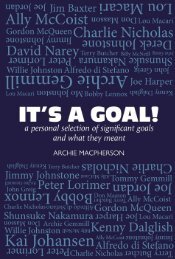Extract from Revolution by Todd Westbrook
You also want an ePaper? Increase the reach of your titles
YUMPU automatically turns print PDFs into web optimized ePapers that Google loves.
14<br />
revolution: a short sharp history of scottish wind power<br />
Asia and across Europe, where their impact stretches to art and<br />
literature. Windmills feature most famously in Don Quixote<br />
<strong>by</strong> Cervantes but also caught the imagination of writers Robert<br />
Louis Stevenson, Hilaire Belloc and even Shakespeare; artists<br />
moved <strong>by</strong> their countenance – to various degrees of obsession<br />
– include Van Gogh, Monet, Constable, Renoir, Rembrandt,<br />
Gauguin and van Ruisdael. Many pre-industrial structures<br />
are still with us, having largely been converted into tourist<br />
attractions, housing, restaurants or bars.<br />
Making the jump <strong>from</strong> brute force to the creation of<br />
electricity came fairly late in the day via pioneering efforts<br />
in the 19th century, after which small wind turbines became<br />
commonplace in the us in the 1900s to supply farms in<br />
remote areas with light and other amenities (the installation<br />
at the beginning of the Wizard of Oz, before it leaps into<br />
its Technicolor phase, perfectly captures the concept). The<br />
era of commercial windpower, driven <strong>by</strong> early experiments<br />
with turbines connected to the main grid supply network –<br />
including one in Scotland – would arrive in the 1970s starting<br />
in California.<br />
In Europe, the Danes and the Germans led an initial<br />
charge in the 1980s with communities and non-utilities the<br />
main proponents; it was more of an environmental and rural<br />
movement than strictly speaking a ‘business’ and deployments<br />
were often approached on an experimental basis with the aim<br />
of advancing the technology. Egalitarian, you could almost say.<br />
Vintage machines were nothing like the graceful structures<br />
in most modern projects, painstakingly arrayed in an eyepleasing<br />
matrix that tumbles rhythmically with the breeze.<br />
Instead the landscape of the 1970s and early 1980s featured<br />
squatty, short-armed and often crowded turbines spinning<br />
on a sometimes wobbly axis at unfathomable speed. Two<br />
blades, three blades, facing into the wind, facing away <strong>from</strong><br />
the wind, perched on top of lattices, wooden poles or towers<br />
made of concrete, maybe of steel segments reinforced with


















